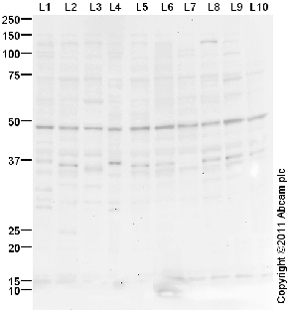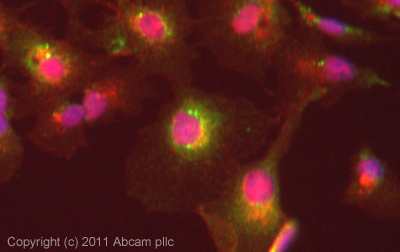
All lanes : Anti-ATTY antibody (ab91450) at 1 µg/mlLane 1 : NIH 3T3 (Mouse embryonic fibroblast cell line) Whole Cell LysateLane 2 : HepG2 (Human hepatocellular liver carcinoma cell line) Whole Cell LysateLane 3 : PC12 (Rat adrenal pheochromocytoma cell line) Whole Cell Lysate Lane 4 : A20 (Mouse B lymphoma cell line) Whole Cell Lysate (ab7180)Lane 5 : Caco 2 (Human colonic carcinoma cell line) Whole Cell LysateLane 6 : SK N BE (Human neuroblastoma) Whole Cell Lysate Lane 7 : MCF7 (Human breast adenocarcinoma cell line) Whole Cell LysateLane 8 : K562 (Human erythromyeloblastoid leukemia cell line) Whole Cell LysateLane 9 : Raji (Human Burkitt's lymphoma cell line) Whole Cell LysateLane 10 : A431 (Human epithelial carcinoma cell line) Whole Cell LysateLysates/proteins at 10 µg per lane.SecondaryGoat Anti-Rabbit IgG H&L (HRP) preadsorbed (ab97080) at 1/5000 dilutiondeveloped using the ECL techniquePerformed under reducing conditions.

ICC/IF image of ab91450 stained HepG2 cells. The cells were 4% PFA fixed (10 min) and then incubated in 1%BSA / 10% normal goat serum / 0.3M glycine in 0.1% PBS-Tween for 1h to permeabilise the cells and block non-specific protein-protein interactions. The cells were then incubated with the antibody (ab91450, 5µg/ml) overnight at +4°C. The secondary antibody (green) was ab96899, DyLight® 488 goat anti-rabbit IgG (H+L) used at a 1/250 dilution for 1h. Alexa Fluor® 594 WGA was used to label plasma membranes (red) at a 1/200 dilution for 1h. DAPI was used to stain the cell nuclei (blue) at a concentration of 1.43µM.

